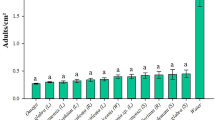Abstract
Lysergol, elymoclavine and three other van Urk-positive alkaloids were identified by 2D chromatography in the seed extract ofIpomoea parasitica. The presence of the same ergoline alkaloids was also demonstrated in vegetative tissue ofI. parasitica. Heliothis virescens larvae reared on a diet containing an alkaloid extract ofI. parasitica showed an increase in the consumption index and a reduction in the effiency of conversion of food. No difference was observed in the approximated digestibility. The percentages of pupation and emergence were reduced and the malefemale ratio was altered in insects fed on a diet containing the alkaloid extract ofI. parasitica or lysergol. The increases in the concentration of ergoline alkaloids inI. parasitica at the seedling stage and at flowering support the theory that these compounds play a defensive role against herbivory in the plant.
Similar content being viewed by others
References
Aerts RJ, Snoeijer W, Aerts-Teerlink O, Van der Mejden E, Verpoorte R (1991) Control and biological implications of alkaloid synthesis inCinchona seedlings. Phytochemistry 30:3571–3577
Clay K, Cheplick GP (1989) Effect of ergot alkaloids from fungal endophyte infected grasses on Fall Armyworm (Spodoptera frugiperda). J Chem Ecol 15:169–182
Friedman M, Dao L, Gumbmann MR (1989) Ergot alkaloids and chlorogenic acid content in different varieties of Morning-glory (Ipomoea spp) seeds. J Agric Food Chem 37:708–712
Hofmann A (1963) The active principles of seeds ofRivea corymbosa andIpomoea violacea. Botanical Museum Leaflets Harvard University 20:194–212
Hofmann A, Tscherter H (1960) Isolierung von Lysergsaure-Alkaloide aus der mexikanischen Zauberdroge Ololiuqui (Rivea corymbosa (L.) Hall. f.) Experientia 16:414
Lewis WH, Elvin-Lewis MPF (1977) Medical Botany. New York: Wiley-Interscience
Rehacef Z, Sajdl P (1990) Bioactive Molecules. Vol. 12. Ergot alkaloids: chemistry, biological effects, biotechnology. Prague: Elsevier Science Publishers
Schultes RE (1941) A contribution to our knowledge ofRivea corymbosa. The narcotic Ololiuqui of the Aztecs. Cambridge: Botanical Museum of Harvard University
Yates SG, Fenster JC, Bartlelt RJ (1989) Assay of fescue seed extract, fractions and alkaloids using the Large Milk Bug. J Agr Food Chem 37:354–357
Author information
Authors and Affiliations
Rights and permissions
About this article
Cite this article
Amor-Prats, D., Harborne, J.B. Allelochemical effects of ergoline alkaloids fromIpomoea parasitica onHeliothis virescens . Chemoecology 4, 55–61 (1993). https://doi.org/10.1007/BF01245897
Issue Date:
DOI: https://doi.org/10.1007/BF01245897




